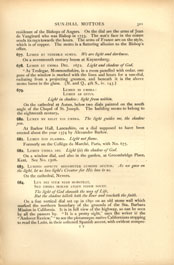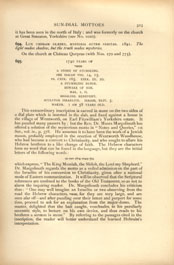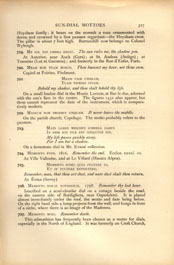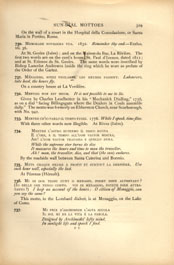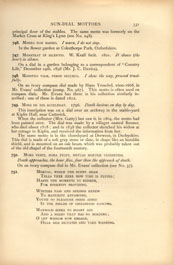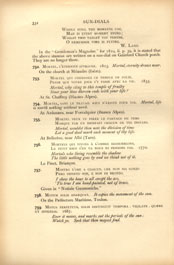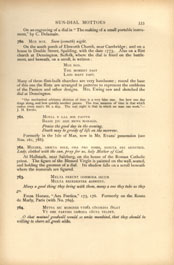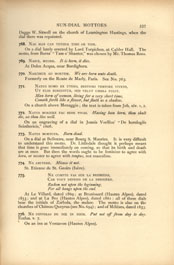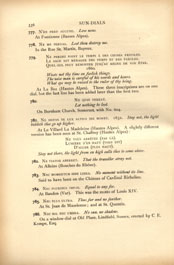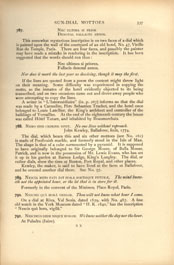Sun-Dial Mottoes (continued.)
residence of the Bishops of Angers. On the dial are the arms of Jean de Vaugirard who was Bishop in 1753. The sun's face in the centre sends its rays towards the hours. The arms of France are on the style, which is of copper. The motto is a flattering allusion to the Bishop's office. |
|
| 677. | LUMEN ET TENEBRÆ SUMUS. We are light and darkness. On a seventeenth century house at Kayserberg. |
| 678. | LUMEN ET UMBRA DEI. 1672. Light and shadow of God. "At Tredegar, Monmouthshire, in a room panelled with cedar, one pane of the window is marked with the lines and hours for a sun-dial, radiating from a projecting gnomon, and beneath it is the above motto burnt in the glass. (N. and Q., 4th S., iv. 143.) |
| 679. | LUMEN IN UMBRA: Light in shadow: light from within. On the cathedral at Autun, below two dials painted on the south angle of the Chapel of St. Joseph. The building seems to belong to the eighteenth century. |
| 680. | LUMEN ME REGIT VOS UMBRA. The light guides me, the shadow you. At Barlow Hall, Lancashire, on a dial supposed to have been erected about the year 1574 by Alexander Barlow. |
| 681. | LUMEN NON FLAMMA. Light not flame. Formerly on the Collège du Marché, Paris, with No. 675. |
| 682. | LUMEN UMBRA DEI. Light (is) the shadow of God. On a window dial, and also in the garden, at Groombridge Place, Kent. See No. 1506. |
| 683. | LUMINIS ASPECTU REDAMETUR LUMINIS AUCTOR. As we gaze on the light, let us love light's Creator for His love to us. On the cathedral, Nevers. |
| 684. | LUX DEI VITÆ VIAM MONSTRAT, On a fine vertical dial set up in 1891 on an old stone wall which marked the northern boundary of the grounds of the Sta. Barbara Mission in California. It is in full view of the highway, so can be seen by all the passers by."It is a pretty sight,"says the writer in the "Andover Review." "to see the picturesque native Californians stopping to read the Latin, in their softened Spanish accent, with evident compre- |
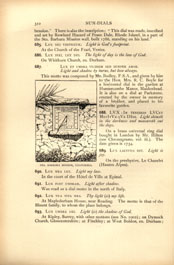
[Full Image]
STA. BARBARA MISSION, CALIFORNIA.
| hension." There is also the inscription: "This dial was made, inscribed and set by Rowland Hazard of Peace Dale, Rhode Island, in a part of the Sta. Barbara Mission wall, built 1786, standing on his land." | |
| 685. | LUX DEI VESTIGIUM. Light is God's footprint. At the Church of the Frari, Venice. |
| 686. | LUX DIEI, LEX DEI. The light of day is the law of God. On Whitburn Church, co. Durham. |
| 687. | LUX ET UMBRA VICISSIM SED SEMPER AMOR. This motto was composed by Mr. Bodley, F. S. A., and given by him to the Hon. Mrs. R. C. Boyle for a horizontal dial in the garden at Huntercombe Manor, Maidenhead. It is also on a dial at Parkstone, erected by the owner in memory of a brother, and placed in his favourite garden. |
| 688. | LVX . IN TENEBRIS LVCET METITVR QVE DIES. Light shineth in the darkness and measureth out the days. On a brass universal ring dial bought in London by Mr. Hilton (see Chronograms, vol. iii.). The date given is 1734. |
| 689. | LUX LAETITIA EST. Light is joy. On the presbytère, Le Chazelet (Hautes Alpes). |
| 690. | LUX MEA LEX. Light my law. In the court of the Hôtel de Ville At Epinal. |
| 691. | LUX POST UMBRAM. Light after shadow. Was read as a dial motto in the north of Italy. |
| 692. | LUX TUA VITA MEA. Thy light (is) my life. At Mapledurham House, near Reading. The motto is that of the Blount family, to whom the place belongs. |
| 693. | LUX UMBRA DEI. Light (is) the shadow of God. At Ripley, Surrey, with other mottoes (see No. 1002); on Dymock Church, Gloucestershire; at Finchley; at West Boldon, co. Durham; |
| it has been seen in the north of Italy; and was formerly on the church at Great Smeaton, Yorkshire (see No. 1020). | |
| 694. | LUX UMBRAM PRÆBET, MYSTERIA AUTEM VERITAS. 1841. The light makes shadow, but the truth makes mysteries. |
| 695. |
1740 YEARS OF This extraordinary inscription is carved in stone on the two sides of a dial plate which is inserted in the slab, and fixed against a house in the village of Wentworth, on Earl Fitzwilliam's Yorkshire estate. It has puzzled many passers by; but the Rev. Dr. Moses Margoliouth has offered a solution of the mysterious motto in "Notes and Queries," Ist Ser., vol. iv., p. 378. He assumes it to have been the work of a Jewish mason, probably employed in the erection of Wentworth Woodhouse, who had become a convert to Christianity, and who sought to allure his Hebrew brethren to a like change of faith. The Hebrew characters form no word that can be found in the language, but they are the initial letters of the following words: הלד משיה שילה יהוה רעי which express, "The King Messiah, the Shiloh, the Lord my Shepherd." Dr Margoliouth regards the motto as a veiled admission on the part of the Israelite of his conversion to Christianity, given after a national mode of Eastern communication. It will be observed that the Scriptural references are confined to the books of the Old Testament, so as not to alarm the inquiring reader. Dr. Margoliouth concludes his criticism thus: "One may well imagine an Israelite or two observing from the road the Hebrew characters, ממשיד for they are very large, and are seen afar off – and after puzzling over their intent and purport for some time, proceed to ask for an explanation from the major-domo. The master, delighted that the bait caught, vouchsafes, in his peculiarly eccentric style, to lecture on his own device, and thus reads to his brethren a sermon in stone." By referring to the passages cited in the inscription, the reader will better understand the learned Hebraist's interpretation. |

[Full Image]
WYCLIFFE-ON-THE-TEES.
| 696. | MACHINA, BIS SEXTAS QUAE JUSTE DIVIDIT HORAS This appears in Paris, on a turret of the Palais de Justice; a sun-dial was formerly there, but has been replaced by a clock. |
| 697. | MAESTIS LENTAE, CELERES GAUDENTIBUS HORAE. Slow to the sorrowing, swift to the joying, pass the hours. At Stra, near Padua; and also, with the first word missing, on a house by the roadside between Ventimiglia and Bordighera. "How lazily time creeps about |
| 698. | MAGNI MOMENTI MINUTIAE. Trifles are of great import. |
| 699. | MAKE HASTE, TIME FLIES. On Lady Ossington's coffee house, Newark. |
| 700. | MAN BEST ERWÄHLT At Nuremberg, recorded in "The Monthly Packet," October, 1886, p. 396. |
| 701. | MAN FLEETH AS A SHADOW. A square dial, once painted red with a green border, is on a gable over the porch of the picturesque old church at Wycliffe-on-the-Tees, and bore the motto from Job, xiv. 2. The dial is now quite defaced and useless. Wycliffe is the reputed birthplace of the great Reformer, and is very beautifully situated. The same motto was formerly on the church at Staindrop, co. Durham; and it is still on a square dial upon the south wall of the aisle of Maxey Church, Northamptonshire. |
| 702. | MAN FLEETH AS IT WERE A SHADOW. 1803. On the south porch of Hamsterley Church, co. Durham. |
| 703. | MAN GOETH TO HIS WORK. CHILDREN OF LIGHT. THE NIGHT COMETH. A REST FOR THE PEOPLE OF GOD. |
These mottoes are inscribed on the four faces of a stone shaft in the churchyard at Upton St. Leonards, Gloucestershire; there are dial-plates on the east, south, and west faces. |
|
| 704. | MAN IS A SHADOW. 1808. Over the porch of Stowmarket Church, Suffolk. |
| 705. | MAN IS LIKE A THING OF NOUGHT, HIS TIME PASSETH AWAY LIKE A SHADOW (Psalm cxliv. 4). On a horizontal dial in Frittenden Churchyard. |
| 706. | MAN'S DAYS ARE AS A SHADOW THAT PASSETH AWAY. With other mottoes on Prince Albert Victor's dial, Edinburgh Exhibition, 1886. See No. 1306. |
| 707. | MANCHER ACTS, MANCHER VERLACHTS, MANCHER BETRACTS. WAS MACHTS? MUSSIGANG MUTTER ALLE LASD(T)ER. OMNIA HUMANA VANA. MEIN WERK JA NICHT VERACHT, BEVOR DU NICHT HAST EIN BESSERES GEMACHT. NI(C)HIL DIFFICILE EST VOLENTI. HORA FUGIT. SIC TRANSIT GLORIA MUNDI. Many a man heeds it, many a man despises it, many a man looks at it. What matters it? Idleness is the mother of all vice. All things human are vain. Be sure you do not despise my handiwork before you have made a better yourself. Nothing is difficult to the willing. The hour flies. So passes the glory of the world. These quaint mottoes are all inscribed on a curious wooden block, bearing several dials, in Mr. Evans' collection. |
| 708. | MANE NOBISCUM, DOMINE, QUONIAM ADVESPERASCIT. Abide with us, O Lord, for it is toward evening (St. Luke, xxiv. 29). This text is written on an illustration of a west dial in a French MS. on dials in the possession of Lewis Evans, Esq. The MS. appears to have been written at Nancy in the first part of the eighteenth century. |
| 709. | MANE PIGER STERTIS, FUGIT HORA. In the morning thou snorest sluggishly – the hour flies. Recorded as a dial motto, but no locality assigned. The first three words are from Persius, 5, 132. |
| 710. | MANE QUAERIS HORAM:In the morning thou askest the hour: later perchance comes thy hour. On two complementary dials at Abriès (Hautes Alpes). |
| 711. | MANEO NEMINI. I wait for no one. There is a dial which bears this inscription, and surrounded by creeper foliage, on Middleton Tyas Hall, near Richmond, Yorks. The |
same motto occurs in a small hamlet, near Baslow, Derbyshire. See No. 330. |
|
| 712. | MANET ULTIMA CŒLO. The end is in heaven. At Regune, Canton de Taverne (Tarn). |
| 713. | MARK WELL MY SHADE, AND SERIOUSLY ATTEND On the sun-dial of Thornby Church, Northamptonshire. |
| 714. | MARQUI QUAND JALO (JE MARQUE QUAND IL GÈLE). I mark (the time) when it freezes. On the façade of the old Mairie at Montolieu (Aude), which stood above one of the now destroyed city gates. In front of this building was a tree which intercepted the rays of the sun, except in winter when it was leafless. The dial then showed the hours. |
| 715. | MAY THE DREAD BOOK AT OUR LAST TRIAL, On a dial which projects from the sill of the library window at Arley Hall, Cheshire, the seat of R. Egerton-Warburton, Esq. It has also Horas non numero nisi serenas. Comp. No. 1384. |
| 716. | MAY THOSE BE BLEST WITH LENGTH OF DAYS This pious tribute to the "glorious and immortal memory" is recorded in "Notes and Queries," 4th Ser., x., November, 1872, as an Orange inscription in the Green County of Roscommon. |
| 717. | ME LUMEN VOS UMBRA REGIT. The light rules me. The shadow you. At Lesneven, in Brittany; in the garden of the hospital of St. Jacques, Besançon (see No. 75); and on the Town Hall, Saltash, with "Edward Stephens, fecit 1727." The first four words and date 1783 are at La Salle (Hautes Alpes). |
| 718. |
ME ORTUM VIDES FORSAN NON OCCASUM.
Risen thou seest On one of the faces of a pillar-dial at Borranshill House, near Carlisle, with No. 1337. The pillar was erected by a member of the |
| Heysham family; it bears on the summit a vase ornamented with doves, and crowned by a lion passant regardant – the Heysham crest. The pillar is about 7 feet high. Borranshill now belongs to Colonel Wybergh. | |
| 719. | ME SOL VOS UMBRA REGIT. The sun rules me, the shadow you. At Auterive, near Auch (Gers); at St. Andras (Ariège); at Tonneins (Lot et Garonne); and formerly in the Rue d'Enfer, Paris. |
| 720. | MEAM NON TUAM NOSCIS. Thou knowest my hour, not thine own. Copied at Poirino, Piedment. |
| 721. | MEAM VIDE UMBRAM, Behold my shadow, and thou shalt behold thy life. On a small leaden dial in the Musée Lorrain, at Bar-le-duc, adorned with the sun's face in the centre. The figures 1432 also appear, but these cannot represent the date of the instrument, which is comparatively modern. |
| 722. | MEDIUM NON DESERIT UNQUAM. It never leaves the middle. On a parish church, Capolago. The motto probably refers to the gnomon. |
| 723. | MEIN LEBEN WEICHET SCHNELL DAHIN On a honestone dial in Mr. Evans' collection. |
| 724. | MEMENTO FINIS. 1816. Remember the end. Ecclus. xxxvi. 10. At Ville Vallouise, and at Le Villard (Hautes Alpes). |
| 725. | MEMENTO HOMO QUIA PULVERE ES, Remember, man, that thou art dust, and unto dust shalt thou return. At Évian (Savoy). |
| 726. | MEMENTO HORAE NOVISSIMAE. 1798. Remember thy last hour. Inscribed on a semi-circular dial on a cottage beside the road, on the eastern side of Bordighera, near Ospedaletti. It is placed almost immediately under the roof, and motto and date being below. On the right hand side a lamp projects from the wall, and hangs in front of a niche, where there is an image of the Madonna. |
| 727. | MEMENTO MORI. Remember death. This admonition has frequently been chosen as a motto for dials, especially in the North of England. It was formerly on Croft Church, |
Yorkshire, dated 1816; and on Rotherham Church (see No. 425). It has been seen on Bishop Middleham Church, dated 1741; on Aycliffe Church, co. Durham; at Wetherall, Cumberland, with No. 66; and also on the Sun-dial Inn at Stroud (see No. 1337). It has been read abroad on a dial at Monthey, Canton Valais, dated 1804; on the church at Amsoldingen, Canton Berne; on the church at Anêt; and at Cherville (Maine et Loire). The same motto is on the church porch at Skipton, Yorkshire. The porch was built in 1866, and replaced an old structure on which there was a stone sun-dial; the present one is of brass. The words also occur in the parish register with a note of the burial, in 1665, of Robert Sutton, M. A., who for "fforty & three years was Vicar of the sayde place. His funeral sermon was preached by his son & onely son Thomas Sutton, on this text (2 Kings, xi. 12), 'Memento mori. One generation goeth & another cometh!'" An older dial, without a motto, is traced on the church tower, which was destroyed during the siege of Skipton Castle in the Civil Wars, 1642-45, and rebuilt by Anne, Countess of Pembroke, in 1655. The same words were chosen by Thackeray for the dial at Castlewood, which figures in one of his beautiful descriptions: "There was in the court a peculiar silence somehow; and the scene remained long in Esmond's memory. The sky bright overhead; the buttresses of the building, and the sun-dial casting shadow over the gilt 'Memento Mori' inscribed underneath; the two dogs – a black greyhound, a spaniel nearly white, the one face up to the sun, and the other snuffing amongst the grass and stones: and my lord leaning over the fountain which was plashing audibly. 'Tis strange how that scene, and the sound of that fountain, remain fixed on the memory of a man who has beheld a hundred sights of splendour and danger, too, of which he has kept no account" ("Esmond," chap. xiv.). A correspondent reminds us that a certain well-known Fellow of Worcester College, Oxford, suggested as the motto for a snuff-box made out of an old mulberry tree, "Memento mori – Remember the mulberry tree." |
|
| 728. | MEMOR ESTO BREVIS AEVI. 1764. Bear in mind how short life is. Over the porch entrance at Bittadon Church, North Devon. The porch is enveloped in ivy, from which the dial face peers out. The same motto, without date, also occurs at Checkley, Staffordshire. So Hotspur: "O gentlemen, the time of life is short, |
| 729. | MEMOR ULTIMAE UTERE PRAESENTI. Declinat G. R. xxxvi. An. Dom. MDCCCXXXIV. Joh. Antonivs Teppati, Tavrini, delineavit. Mindful of the last (hour), employ the present. |
|
On the wall of a court in the Hospital della Consolazione, or Santa Maria in Portico, Rome. |
|
| 730. | MEMORARE NOVISSIMA TUA. 1832. Remember thy end. – Ecclus. vii. 36. At St. Geoire (Isère); and on the Maison du Bac, La Rivière. The first two words are on the curé's house, St. Paul d'Izeaux, dated 1812; and at St. Etienne de St. Geoirs. The same words were inscribed by Bishop Lancelot Andrewes inside the ring which he wore as prelate of the Order of the Garter. |
| 731. | MÉNAGERS, SOYEZ VIGILANTS, LES HEURES PASSENT. Labourers, take heed, the hours fly. On a country house at La Verdière. |
| 732. | MENTIRI NON EST MEUM. It is not possible to me to lie. Given by Charles Leadbetter in his "Mechanick Dialling," 1756, as on a dial "facing Billingsgate where the Dealers in Coals assemble daily." The motto was formerly on Ebberston Church, near Scarborough, with No. 942. |
| 733. | MENTRE CH'IO PARLO IL TEMPO FUGGI. 1776, While I speak, time flies. With three other words now illegible. At Rives (Isère). |
| 734. | MENTRE L'ASTRO SUPREMO IL DISCO RUOTA By the roadside wall between Santa Caterina and Bormio. |
| 735. | METS CHAQUE HEURE À PROFIT ET SURTOUT LA DERNIÈRE. Use each hour well, especially the last. At Pézenas (Hérault). |
| 736. | MI DI OOR TEGNI CUNT O MENASIN, PODET DINN ALTRETANT? (IO DELLE ORE TENGO CONTO. VOI DI MENAGGIO, POTETE DIRE ATTRITANTO?) I keep an account of the hours; O citizen of Menaggio, can you say the same? This motto, in the Lombard dialect, is at Menaggio, on the Lake of Como. |
| 737. | MI FECE D'ARCHIMEDE L'ALTA SCUOLA |
This motto, with the date 1859, and name, "Carolus Sachi, Trigon, desine, pinxit," is on a dial erected on the wall of one of the courts of the immense château of the Counts Arconati, at Rho, near Milan. The last descendant of this ancient Milanese family, which dated from the fourteenth century, was buried at Milan in 1870. |
|
| 738. | MIA VITA È IL SOL: DELL' UOM LA VITA È DIO; On the wall of a monastery, now suppressed, in the neighbourhood of Florence. |
| 739. | MIG LEDER SOLEN EI SKUGGEN. The sun leads me, not the shadow. This was read in 1897 on the inside band of a globe dial which was lying on a rubbish heap in an outhouse at the royal residence, Rosendal Djurgarden, near Stockholm. |
| 740. | MIHI DEVS LVX ET SALVS. God is my light and salvation. At Hadleigh, Suffolk (see No. 1393). A chronogram, A.D. 1627. |
| 741. | MIND YOUR BUSINESS. On a church tower at Furneaux Pelham, Herts, with No. 1408; formerly at Falsgrave, Scarborough. |
| 742. | MINUTÆ SUNT QUÆ SPECTAS, NON QUÆ PERDIS. What you look at are minutes, not what you lose. A moment – mark how small a space On a sun-dial in Oxford, near the Clerk of the Peace's office. The dial bears the arms of Thomas, Earl (afterwards Marquis) of Wharton, Lord Lieutenant of Oxfordshire from 1691 to 1702. |
| 743. | MISSPEND NO TIME. At Micheldean (see No. 354). "Employ thy time well if thou meanest to gain leisure, and since thou art not sure of a minute, throw not away an hour." – BENJAMIN FRANKLIN. |
| 744. | MOBILE TEMPUS HORA NON REMORANTE FUGIT. The hour stays not, the time quick moving flies. At Moulins. |
| 745. | MONEO, DUM MOVEO. I warn whilst I move. Formerly on a summer-house at Danby Hall, near Leyburn, Yorkshire; but the dial has now been moved, and placed above the |
| principal door of the stables. The same motto was formerly on the Market Cross at King's Lynn (see No. 248). | |
| 746. | MONEO NON MANEO. I warn, I do not stay. In the flower garden at Cokethorpe Park, Oxfordshire. |
| 747. | MONSTRAT IN SILENTIO. W. Keall fecit. 1801. It shows (the hour) in silence. On a dial in a garden belonging to a correspondent of "County Life," December 24th, 1898 (Mr. J. C. Davies). |
| 748. | MONSTRO VIAM, PERGE SECURUS. I show the way, proceed trustfully. On a ivory compass dial made by Hans Troschel, 1600-1668, in Mr. Evans' collection (comp. No. 967). This motto is often used on compass dials. Mr. Evans has three in his collection similarly inscribed; one of these is dated 1612. |
| 749. | MORS DE DIE ACCELERAT. 1796. Death hastens on day by day. This inscription was on a dial over an archway in the stable-yard at Kiplin Hall, near Catterick. When the collector (Mrs. Gatty) last saw it, in 1864, the motto had been painted over. The dial was made by a villager named Bonner, who died about 1818; and in 1838 the collector sketched his widow at her cottage in Kiplin, and received the information from her. The same motto is in the churchyard at Derwent, in Derbyshire. This dial is made of a soft gray stone or slate, in shape like an heraldic shield, and is mounted on an oak beam, which was probably taken out of the old chapel of the fourteenth century. |
| 750. | MORS VENIT, HORA FUGIT, METUAS MORTEM VENIENTEM. Death approaches, the hour flies, fear thou the approach of death. On an ivory compass dial in Mr. Evans' collection (see No. 37). |
| 751. |
|
WISELY STILL THE MOMENTS USE, In the "Gentleman's Magazine" for 1829, ii. p. 39, it is stated that the above stanzas are written on a sun-dial on Gainford Church porch. They are no longer there. |
| 752. | MORTEL, L'ÉTERNITÉ APPROCHE. 1823. Mortal, eternity draws near. On a church at Méaudre (Isère). |
| 753. | MORTEL QUI CHÉRISSEZ CE TEMPLE DE FOLIE, At St. Chaffrey (Hautes Alpes). |
| 754. | MORTEL, SANS LE TRAVAIL RIEN N'EXISTE POUR TOI. Mortal, life is worth nothing without work. At Ardennes, near Forcalquier (Basses Alpes). |
| 755. | MORTEL VEUX TU FIXER LE PARTAGE DU TEMS At Bellerive, near Albi (Tarn). |
| 756. | MORTELS QUI VIVONS À L'OMBRE RESSEMBLONS, Le Pinet, Briançon. |
| 757. | MOSTRO L'ORE A CIASCUN, CHE NON SIA GONZO Given in "Notizie Gnomoniche." |
| 758. | MOTUM SOLIS ADAEQUAT. It copies the movement of the sun. On the Préfecture Maritime, Toulon. |
| 759. | MOTUS PERPETUUS, SOLIS DISTINGUIT TEMPORA . VIGILATE . QUÆRE UT INVENIAS. 1687. Ever it moves, and marks out the periods of the sun; |
|
On an engraving of a dial in "The making of a small portable instrument," by C. Delamain. |
| 760. | MOX NOX. Soon (cometh) night. On the south porch of Elsworth Church, near Cambridge; and on a house in Double Street, Spalding, with the date 1773. Also on a flint church at Dennington, Suffolk, where the dial is fixed on the battlement, and beneath, on a scroll, is written: MOX NOX. Many of these flint-built churches are very handsome; round the base of this one the flints are arranged in patterns to represent the emblems of the Passion and other designs. Mrs. Ewing saw and sketched the dial at Dennington. "Our mechanical arbitrary division of time is a very false one. See how one day drags along, and how quickly another passes. The true measure of time is that which makes every man's life a day. The real night is that in which no man can work." – J. H. Ewing. |
| 761. | MOYLL Y LAA MIE FASTYR Formerly in the Isle of Man, now in Mr. Evans' possession (see Nos. 161, 788). |
| 762. | MULIER, AMICTA SOLE, ORA PRO NOBIS, SANCTA DEI GENITRIX. Lady, clothed with the sun, pray for us, holy Mother of God. At Hallstadt, near Salzburg, on the house of the Roman Catholic priest. The figure of the Blessed Virgin is painted on the wall, seated, and holding the gnomon of a dial. Its shadow falls on a scroll beneath where the numerals are figured. |
| 763. | MULTA FERUNT COMMODA SECUM Many a good thing they bring with them, many a one they take as they go. From Horace, "Ars Poetica," 175, 176. Formerly on the Route de Marly, Paris (with No. 769). |
| 764. | MVTVA SIC HOMINES VTIÑA CÕCORDIA ĨVGAT O that mutual goodwill would so unite mankind, that they should be willing to share all goods alike. |

[Full Image]
ABBEYFIELD, NEAR SHEFFIELD.
|
TYNDARIDÆ ALTERNIS FRATRES VIXERE DIEBUS, The sons of Tyndarus lived on alternate days, but one day cuts the thread of our life. Seen on the cathedral at Albi, in 1877. The mottoes were upon two dials, facing east and west; the gnomons had disappeared, and the numerals were nearly illegible. Above each dial was an angel bearing a scroll. |
| 765. | MY CHANGE IS SURE, IT MAY BE SOON, On the south wall of the Unitarian chapel, at Blackley, Lancashire. |
| 766. | MY DAYS ARE LIKE A SHADOW THAT DECLINETH. – Psalm cii. II. Over the door of St. Vigean's church, Arbroath, N.B.; and on a horizontal dial supported by a cluster of light columns, in Haley Hill Cemetery, near Halifax. There is no date, but the dial was probably erected in 1856 when the cemetery was opened. "Every day is a little life, in the account whereof we may reckon a birth from the womb of the morning, our growing time from thence to noon (when we are as the sun in its strength); after which, like a shadow that declineth, we hasten to the evenings of our age, till at last we close our eyes in sleep, the image of death; and our whole life is but the tale of a day told over and over." – SIR WILLIAM WALLER. |
| 767. |
MY TIME IS IN THY HAND. – Psalm xxxi. 17. This text was engraved on the base of a pedestal, bearing a horizontal dial, which stood in the garden of Bradfield Rectory, Sheffield, whilst the Rev. Reginald Alfred Gatty was rector there. The dial plate has since been removed. The same text was adopted by the late Bernard Wake, Esq., and placed by him, with verse 18 from the same Psalm (xxxi.) on a handsome vertical dial at Abbeyfield near Sheffield. It was recently inscribed (with No. 645) by H. R. H. the Princess of Wales on a dial at Sandringham; and in 1899 was placed by the Rev. |
| Degge W. Sitwell on the church of Leamington Hastings, when the dial there was repainted. |
| 768. | NAE MAN CAN TETHER TIME OR TIDE. On a dial lately erected by Lord Torpichen, at Calder Hall. The motto, from Burns' "Tam o' Shanter," was chosen by Mr. Thomas Ross. |
| 769. | NASCE, MUORE. It is born, it dies. At Dolce Acqua, near Bordighera. |
| 770. | NASCIMUR AD MORTEM. We are born unto death. Formerly on the Route de Marly, Paris. See No. 763. |
| 771. | NATUS HOMO EX UTERO, BREVIORI TEMPORE VIVENS, On a church above Menaggio; the text is taken from Job, xiv. I, 2. |
| 772. | NATUS MORIERE FAC BENE VIVAS. Having been born, thou shalt die, see thou live well. On an engraving of a dial in Joanis Voellius' "De horologiis Sciothericis," 1608. |
| 773. | NATUS MORTUUS. Born dead. On a dial at Bellentre, near Bourg S. Maurice. It is very difficult to understand this motto. Dr. Littledale thought it perhaps meant that time is gone immediately on coming, so that its birth and death are at once. But then the words ought to be feminine to agree with hora, or neuter to agree with tempus, not masculine. |
| 774. | NE ABUTERE. Misuse it not. At Etienne de St. Geoirs (Isère). |
| 775. | NE COMPTE PAS SUR LA PREMIÈRE, At Le Villard, dated 1869; at Brunissard (Hautes Alpes), dated 1853; and at La Bez (Hautes Alpes), dated 1861: all of these dials bear the initials of Zarbula, the maker. The motto is also on the churches of Château Queyras (see No. 694); and of Mélézes, dated 1853. |
| 776. | NE DIFFERAS DE DIE IN DIEM. Put not off from day to day. Ecclus. v. 7. On an inn at Ventavon (Hautes Alpes). |
| 777. | N'EN PERD AUCUNE. Lose none. At Fontienne (Basses Alpes). |
| 778. | NE ME PERDAS. Lest thou destroy me. At the Rue St. Martin, Bayeux. |
| 779. | NE PERDEZ POINT LE TEMPS À DES CHOSES FRIVOLES. At La Bez (Hautes Alpes). These three inscriptions are on one dial, but the last line has been added later than the first two. |
| 780. | NE QUID PEREAT. On Burnham Church, Somerset, with No. 604. |
| 781. | NE SISTAS TE LUX ALTIUS IRE MONET. 1832. Stay not, the light biddeth thee go up higher. At Le Villard La Madeleine (Hautes Alpes). A slightly different version has been seen at St. Chaffrey (Hautes Alpes): NE VOUS ARRÊTEZ (PAS LÀ). Stay not there, the light from on high calls thee to come above. |
| 782. | NE VIATOR ABERRET. That the traveller stray not. At Alleins (Bouches du Rhône). |
| 783. | NEC MOMENTUM SINE LINEA. No moment without its line. Said to have been on the Château of Cardinal Richelieu. |
| 784. | NEC PLURIBUS IMPAR. Equal to any foe. At Bauden (Var). This was the motto of Louis XIV. |
| 785. | NEC PLUS ULTRA. Thus far and no farther. At St. Jean de Maurienne; and at St. Quentin. |
| 786. | NEC SOL NEC UMBRA. No sun, no shadow. On a window-dial at Old Place, Lindfield, Sussex, erected by C. E. Kempe, Esq. |
| 787. | NEC ULTIMA SI PRIOR This somewhat mysterious inscription is on two faces of a dial which is painted upon the wall of the courtyard of an old hotel, No. 47, Vieille Rue du Temple, Paris. There are four faces, and possibly the painter may have made a mistake in rendering in the inscription. It has been suggested that the words should run thus: Nec ultimos si priores, Nor does it mark the last year as deceiving, though it may the first. If the lines are quoted from a poem the context might throw light on their meaning. Some difficulty was experienced in copying the motto, as the inmates of the hotel evidently objected to its being transcribed, and on two occasions came out and drove away people who were attempting to copy the lines. A writer in "L'Intermédiaire" (ix. p. 267) informs us that the dial was made by a Carmelite, Père Sebastien Trachet, and the hotel once belonged to Louis Latellier, the King's architect and controller of the buildings of Versailles. At the end of the eighteenth century the house was called Hôtel Tarare, and inhabited by Beaumarchais. |
| 788. |
NEMO SINE CRIMINE VIVIT. No one lives without reproach.
This dial, which bears this and six other mottoes (see No. 161) is made of Pooilvaish marble, and formerly stood in the Isle of Man. The shape is that of a cube surmounted by a pyramid. It is supposed to have originally belonged to Sir George Moore, of Balla Mooar, Patrick, and is now in the possession of Mr. Lewis Evans, who has set it up in his garden at Barnes Lodge, King's Langley. The dial, or rather dials, show the time at Boston, Port Royal, and other places. Kewley, the maker, is said to have lived at the farm at Ballafreer, and he erected another dial there. See No. 57. |
| 789. | NESCIA MENS FATI EST HORÆ SORTISQUE FUTURÆ. The mind knoweth not the appointed hour, or the lot that is in store for it. Formerly in the convent of the Minimes, Place Royal, Paris. |
| 790. | NESCIES QUÂ HORÂ VENIAM. Thou wilt not know what hour I come. On a dial at Riva, Val Sesia, dated 1829, with No. 487. A fine old watch in the York Museum dated "H. K. 1840," has the inscription "Nescis quâ hora vigilâ." |
| 791. | NESCIMUS DIEM NEQUE HORAM. We know neither the day nor the hour. At Paladru (Isère). |
| 792. | NESCIT OCCASUM LUMEN ECCLESIAE. The light of the Church knows no setting. At Standish Vicarage, Gloucestershire. There is a hidden meaning in this motto, due to its having been chosen by Bishop Frampton, who was deprived of the See of Gloucester as a non-juror, but was permitted to hold the vicarage of Standish, and died there in 1708. He erected the dial, and in addition to the allusion to his career, which he put into the motto, he had the gnomon shaped like the sword of the See, reversed, and pointing upwards, as an emblem of martyrdom. He is buried within the sanctuary of Standish Church, and his gravestone bears the quaint inscription, "Robertus Frampton Episcopus Gloucestrensis, caetera quis nescit?" |
| 793. | NESCITIS DIEM NEQUE HORAM. 1715. Ye know neither the day nor the hour (St. Matt. xxv. 13). On the chapel of the Addolorato, Moltrasio, Lago di Como: on the Abbaye du Ronceray at Angers; and the Château de Terrebasse (Isère). It is also given in Kircher's "Ars Magna Lucis et Umbræ. 1571." |
| 794. |
Given in "Notizie Gnomoniche." |
| 795. | NIHIL SINE SOLE. 1861. Nothing without the sun. At Aiguilles, and at La Verdière (Var); also seen on a portable dial at Frankfort, with the additional word lumine and date, 1711. |
| 796. | NIHIL SUPRA. There is nothing higher. At Les Avenières (Isère); and seen at Monquin in 1778. |
| 797. | NIHIL VOLENTIBUS ARDUUM. Nothing is difficult to the willing. Is on a dial at Fyning House, Sussex, which was erected in the reign of George II. |
| 798. | NIL ALIUD EST VIVERE QUAM MORI. Life is nought else but death. At Les Avenières (Isère), dated 1838. |
| 799. | NIL NI SIT SOL MI. Less than nothing without the sun. At Alzo, on the Lake of Orta, North Italy. |
| 800. | NIL NISI CAELESTI RADIO. Nought save by a ray from heaven. Applicable alike to the dial, the church, and the services, this motto is over the south door of the church of St. Mary the Virgin, at Lower |
| Heyford, in Oxfordshire, where there has been a church from before the Conquest. It is also found near Baslow with other mottoes (see No. 330); and on a house at Beau Coin, Jersey. | |
| 801. | NIL NOMEN NIL FAMA JUVAT NIL CANDIDA VIRTUS: TEMPUS ENIM RAPIDO SINGULA DENTE VORAT.
Nought doth a name, nought doth renown avail, nought doth bright valour:
On a large brass astrolabe and sun-dial, in the Museum at Perugia. On the reverse side of the plate is – "Ieronomus Wulparia, Florentinus, faciebat A.D. MDLXXVII," and a second motto. See No. 424. |
| 802. | NIL SINE NOBIS. A. B. F. 1674. Nothing exists without us. A dial on the wall of a courtyard on the south side of the Hôtel Cluny, Paris, had this inscription. The word nobis referred to the rays of the sun which were represented on its face. The Hôtel Cluny, a very beautiful specimen of rather elaborate fourteenth century Gothic architecture, was bought in 1625 for the abbess and nuns of Port Royal, and was known as Port Royal de Paris. It was re-established by Louis XIV. in 1665, on a fresh basis, and was looked upon as schismatic by the community of Port Royal des Champs. This dial must have been erected in the time of the first abbess of the new foundation, Sœur Dorothée Perdreau, who held office till 1684. |
| 803. | NISI DOMINUS AEDIFICAVERIT DOMUM IN VANUM LABORAVERUNT QUI AEDIFICANT EAM. Except the Lord build the house, they labour in vain that build it (Ps. cxxvii. I). On a house called the Moulin du Pied, dated 1719, at Le Fontenil sous Briançon. |
| 804. |
|
NOR GRUDGED BE THIS MEMORIAL, IF ITS TRUTH In the garden of the Vicarage House at Borden, Kent, there is a pedestal bearing a sun-dial and having on its eastern and western sides two tablets inscribed with these acrostic epitaphs to the memory of a favourite Newfoundland watch dog, called "Neptune," by his sorrowing owner. These lines recall Lord Byron's "Inscription on the Monument of a Newfoundland Dog," dated Newstead Abbey, October 30th, 1808. |
|
| 805. | NO MARBLE POMP, NO MONUMENTAL PRAISE; Quoted in the "Gent. Mag.," vol. xiv., p. 332, A.D. 1774, from Faulkner's "Dublin Journal," as "Inscription on a dial to be erected by his desire on the grave of Edward Bond, of Bondvil, in the county of Armagh, Esq." |
| 806. | NOBIS PEREUNT ET IMPUTANTUR HORAE. The hours perish to us, and are accounted also to us. On the cathedral of St. Colman, at Cloyne, near Cork. ET NOBIS PEREUNT ET IMPUTANTUR may be read at Les Crottes, near Embrun (Hautes Alpes). |
| 807. | NOISELESS FALLS THE FOOT OF TIME This quotation from a song by the Hon. W. R. Spencer is inscribed on the vase of a stone pedestal with a horizontal dial, in the garden of Jordan Gate, Macclesfield, erected by Samuel Pearson, Esq., and Jane, his wife. The name "Quiz" and date 1876, are also carved on the stone, in memory of a favourite terrier who was buried close by. On the dial plate is No. 980. |
| 808. | NOLI CONFIDERE NOCTI. Trust not to the night. On the Manor House, Mickleton, co. Gloucester. |
| 809. | NON CEDIT UMBRA SOLI. The shadow yieldeth not to the sun. A horizontal dial with the gnomon turned towards the sun, and this motto accompanying it, was the device of Giovanni Trivulzio, Governor |
